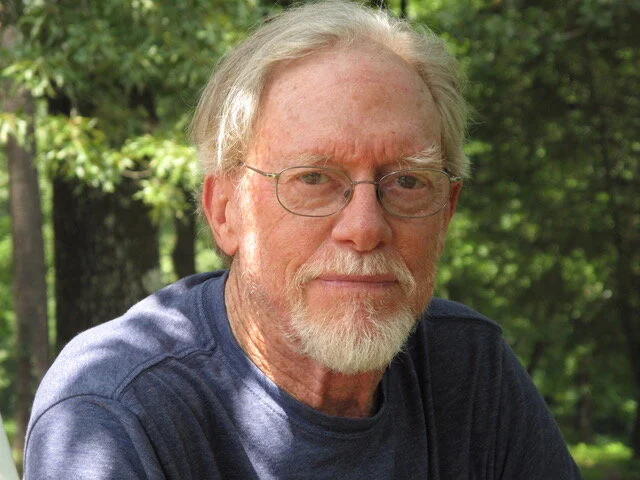Interview with artist Aaron Calvert
Aaron Calvert is a ceramicist living in Russellville, Arkansas. Shortly after earning his MFA in ceramics from Edinboro University of Pennsylvania in 2003, Aaron and his wife Summer Bruch relocated to Arkansas so he could take a teaching position at Henderson State University, where he is currently Professor of Art. His brightly-colored figures are often caricatures of human and animal forms, decorated with what he calls “brain rattles” – recurring thoughts and patterns (think of earworms). The result is both fascinating and uplifting. Aaron’s work is highly acclaimed, and he was the 2020 Delta Exhibition Grand Award Winner. For information on his work, contact him directly at aaroncalvertceramics@gmail.com.
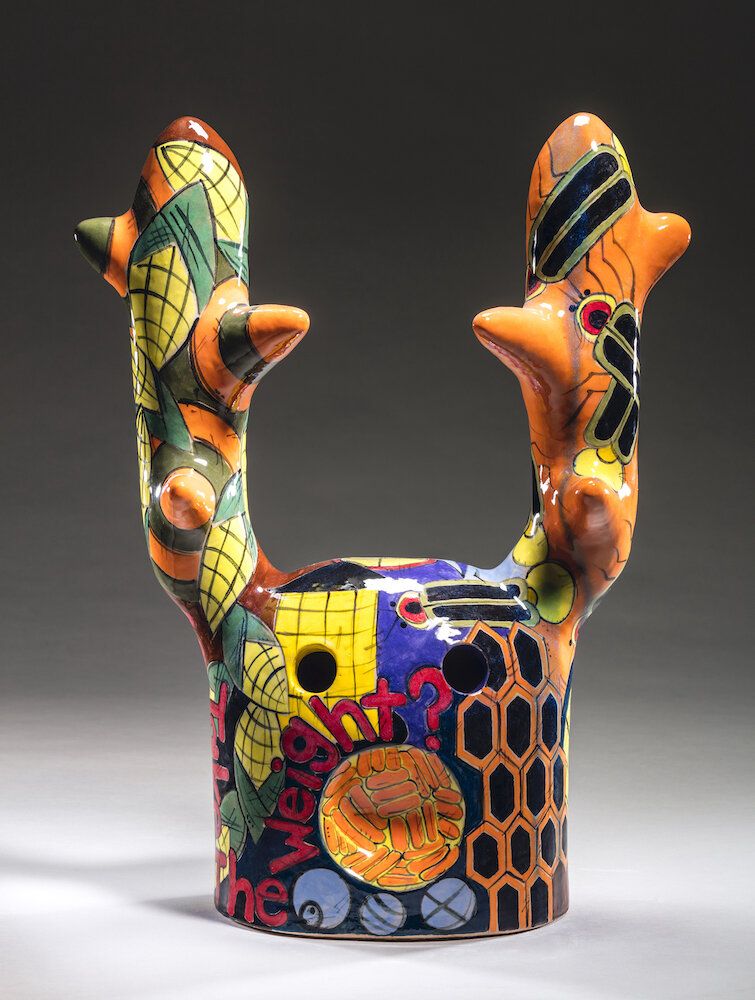
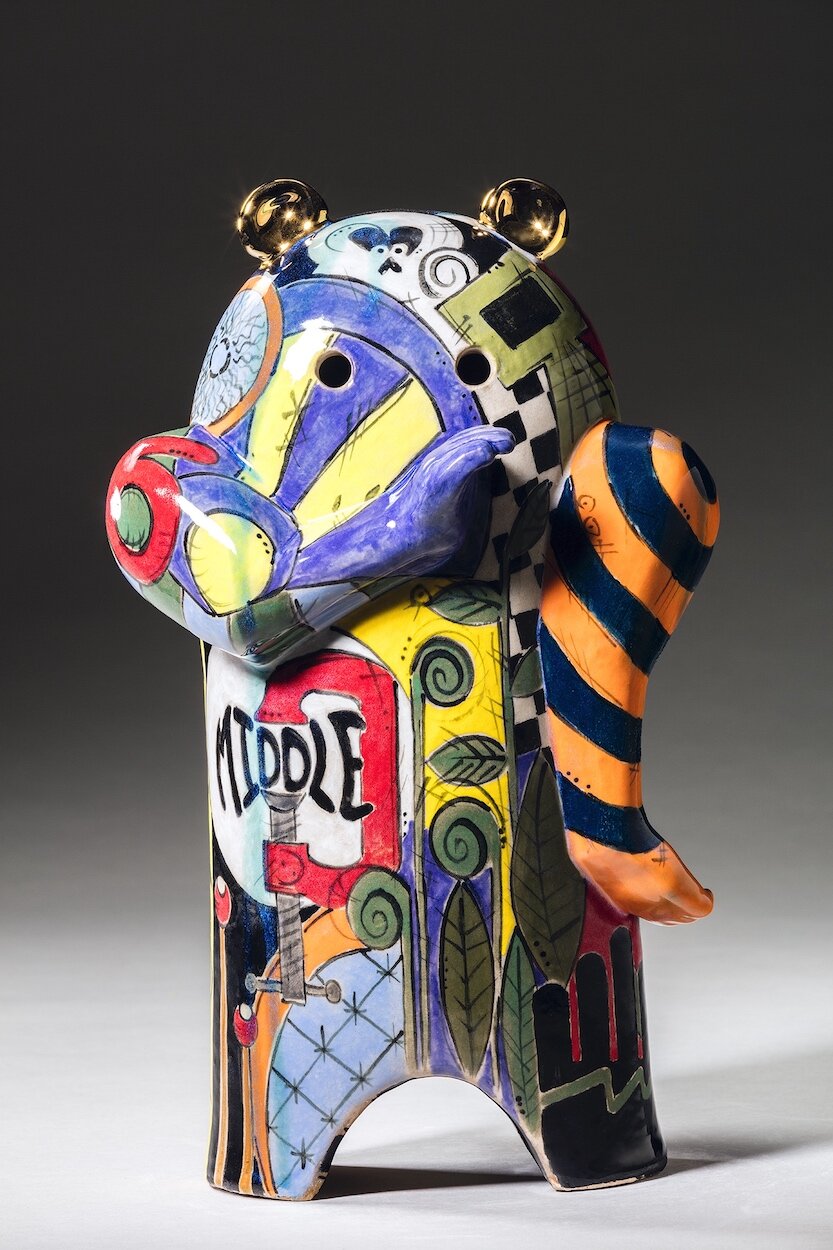
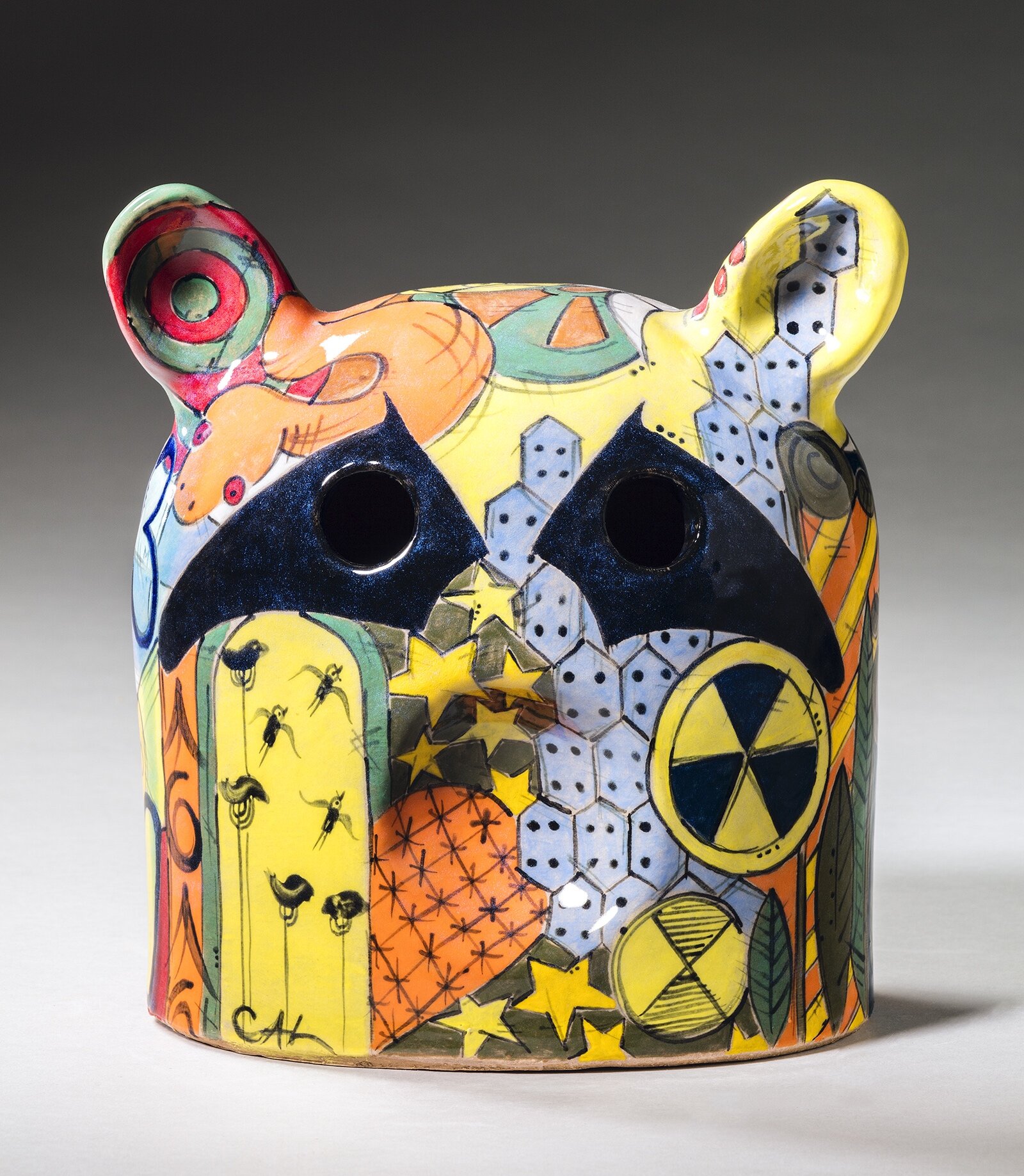
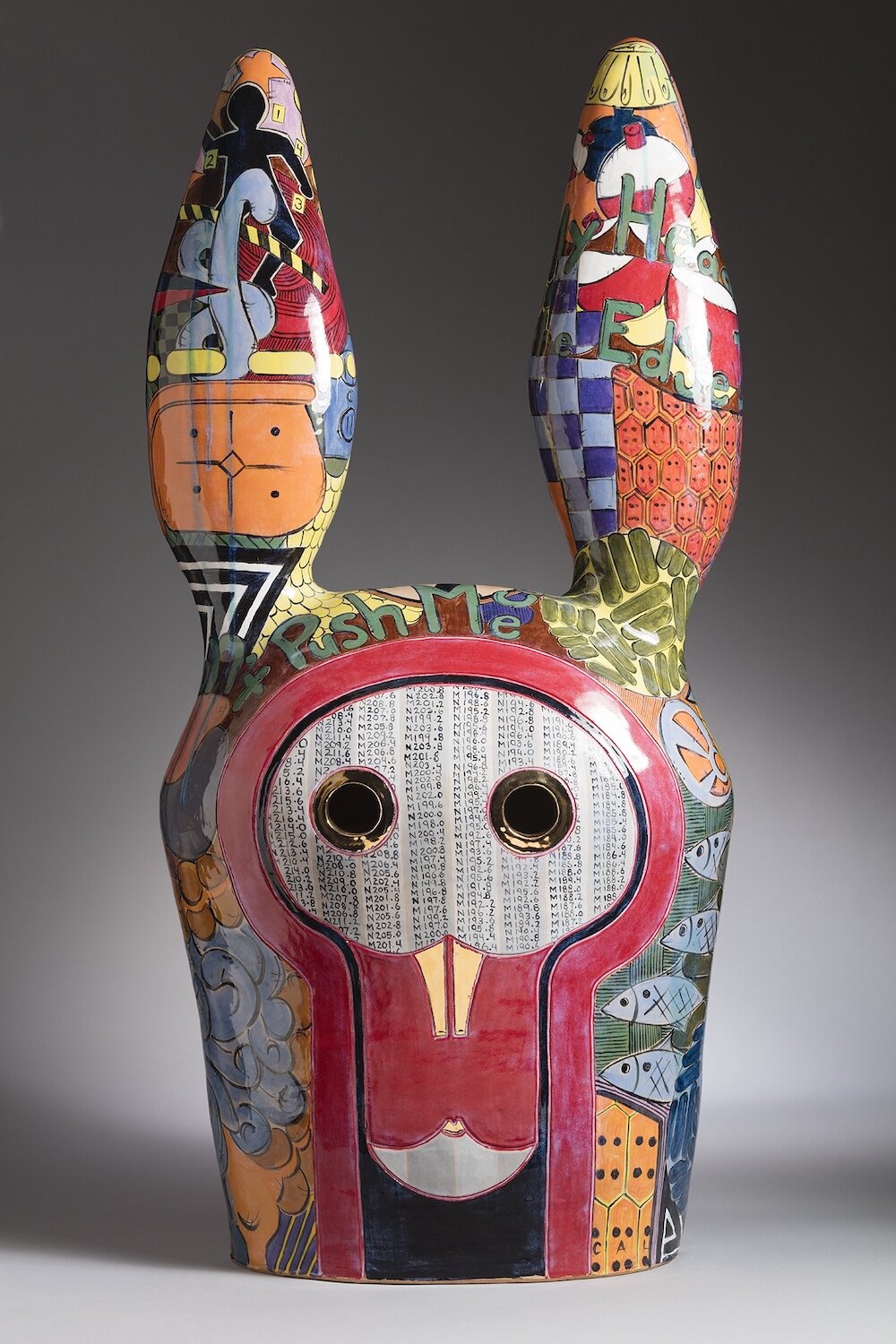
AAS: Aaron, you are Professor of Art at Henderson State University and have been there since 2005. Would you talk about your background and what brought you to HSU?
AC: I grew up in Litchfield, Ohio. It’s a small town of around 3,000 people. It’s largely made up of farmers or blue-collar workers who commute to Cleveland or Akron. I often describe it like Mayberry in The Andy Griffith Show. Everyone knows one another and they still have ice cream socials during the summer months. As a kid, it was ideal. I was always outside and had the freedom to explore nature.
I was diagnosed with dyslexia in 1st grade and had teachers that really invested in me. Their impact made me want to pursue teaching. I graduated with a BFA in crafts from Kent State University and a MFA in ceramics from Edinboro University of Pennsylvania. I’m proud to say that I’m a first generation college graduate.
Coming to Henderson State was just a weird deal. I had finished my MFA and was working in Ohio for Laguna Clay Company. A friend from my undergraduate days called me out of the blue and asked if I would come to Arkansas to help prepare his house for sale. He was the ceramics professor at HSU and told me to bring my portfolio. I interviewed for a one-year emergency hire position. I figured I would get a year of college teaching experience and they would hire a more seasoned candidate when they conducted the national search. After a year of teaching at Henderson State my chair at the time, Nancy Dunaway encouraged me to reapply for the full time job. Spoiler, I got the job.
AAS: Was making ceramics something that always interested you?
AC: Absolutely not, I kind of fell into it. Kent State had a unique BFA crafts option for students studying art. It allowed me to take all the traditional fine arts studios along with craft studios like ceramics, jewelry, metals, glass, and fibers. Although I wasn’t initially drawn to ceramics, I quickly realized that particular studio was special. There was a sense of community there and I enjoyed the physicality of working with clay. While at Kent, I studied with Kirk Mangus and Eva Kwong. They became strong mentors in my life and helped me visualize what it means to be an artist.
“I’ve always viewed the surfaces of my pieces as a documentation of myself. The images represent both the mundane and important things in my life.”
AAS: Maybe I am so fascinated by the way you combine ceramic shapes with paintings and symbols because I just happen to be re-reading The Lost Symbol by Dan Brown, The Da Vinci Code guy. Do any of your pieces have secret messages ;)?
AC: Of course there are hidden messages but no clues to treasure. Maybe I need to incorporate coordinates for geocaching. When I first began making these pieces I had a notebook of symbols I created, images from other cultures, patterns, Morse code, and song lyrics. I had rules and would only use those symbols… from my notebook. As time passed I began adding new items. I even use my phone to capture things for future reference.
I’ve always viewed the surfaces of my pieces as a documentation of myself. The images represent both the mundane and important things in my life. I really don’t think a viewer of my work needs to understand the personal meaning behind each image. They can simply have fun discovering the bright images wrapping around my forms.
AAS: You have been in four Delta Exhibitions, earned two Honorable Mentions, and in 2020 you received the Grand Award. Despite it being a virtual exhibition, it still must have been an exciting time. Would you talk about that and about Rocket Rabbit?
AC: When I moved to Arkansas I quickly realized the Delta was one of the strongest contemporary shows in this region. I really appreciate having new jurors every year and not having a theme based exhibit. The openings were always great because I could visit with so many of my art friends at one event.
Winning the Grand Award in 2020 was totally unexpected. I’m always happy to get a ceramic piece in the show. Summer and I were watching live at home when the image of Rocket Rabbit popped onto the computer screen. She just threw her arms around me and was screaming. My phone blew up with friends texting and calling. The traditional in person opening would have been great but I could totally feel the love with people reaching out and reposting coverage on social media. Rocket Rabbit, was completed right before the pandemic so there isn’t a reference to Covid-19. Ironically the Zika virus had been in the news and the red pregnant woman symbol on the front of the rabbit was from an airport poster warning of that virus. The constellation Lepus wraps around the rabbit’s left ear and a model rocket parachutes across the piece. My daughters and I were building rockets at the time and so the title of the piece references those moments.
I’m really not in the loop with these things, but I did notice there was no call for entry in 2021. I really hope the Delta isn’t a thing of the past.
Rocket Rabbit, 20” x 12” x 8”, stoneware clay, underglaze, gold enamel, 2020 Delta Exhibition Grand Award Winner
AAS: I did attend your recent show, Gone to Seed with Susan Chambers, still on exhibition at Historic Arkansas Museum. It is terrific and a great opportunity for people in the Little Rock area to see your work, which really should be seen in person.
AC: Wow, I appreciate you attending the show. Sunglasses are a must for that exhibit. I don’t have a website or gallery representation so exhibits have always been a major way for me to engage an audience. Over the past year and a half, I really missed attending openings and meeting people. My wife Summer and I are currently putting together a home studio in Russellville. She is also a ceramist and the head of the art department at Arkansas Tech. I’m envisioning how the studio might allow us to connect with others interested in ceramics.
AAS: One piece I find especially fascinating is Going Native. Would you talk about that piece? It is just extraordinary.
AC: Going Native was made around the same time as the Giving Figure. It’s kind of a transition piece between the stand-alone figure and animal sculptures that would follow. As a kid I felt really connected to nature. I earned Eagle Scout and spent a great deal of time hunting with my dad and friends. I was constantly engaging with nature and became very in tune with seasonal transitions. I could spend hours listening to my surroundings. When I went off to college those experiences became less accessible.
Around 2015, I purchased a small boat and began to explore DeGray Lake. I would fish several times a week, eat the fish, and swim in the lake. Looking back, I think I was trying to shed some of the self-imposed hectic stuff that seemed to gobble up my time. I was once again communing with nature. The figure in Going Native is worshiping or surrendering to the bear, which I see as a symbol for nature. A small crack developed between the figure’s legs and I was on the verge of chucking it in the dumpster. I choose to see it through. I used diamond plate, bolts, and a thin piece of red foam to cover the area. Cracks are heartbreaking but they also offer a challenge. I think about Japanese pots repaired with lacquer and powdered metal (Kintsugi). To me those pots are visually stronger with the repair. I want my sculptures to also be visually stronger if a repair is needed.
Going Native, 13” x 13” x 8”, stoneware clay, underglaze, gold enamel
AAS: I know you are a competitive bass fisherman, so we have to talk about Big’Un and its symbolism.
Big’Un, 8” x 20” x 4”, stoneware clay, underglaze
AC: I began competitive bass fishing when I moved to Arkansas. I joined Arkadelphia Bass Club to meet new people and get out on some of Arkansas’s beautiful lakes. Bass fishing has definitely become a passion of mine. I’ve begun casting my own soft plastic lures and usually fish a couple of circuits each year. Before Big’Un, I had never sculpted a fish. I was working on a show during a sabbatical and wanted to add some variety to my forms. Everything else in the show was earth bound and I like how the fish levitates on its fins. There are images of fresh water jellyfish that I’ve seen in DeGray Lake, an Ebola virus, corn, Japanese Oribe patterns… “Five Feet High and Rising” by Johnny Cash was playing in my head while working on the surface. On the other side I wrote “How High’s the Water Bobby” which references Cash’s song and is specific to a person who would monitor a creek that routinely floods outside the ceramics studio at HSU.
AAS: Always Facing South Bear is a wonderfully fun piece – large and packed with images. It was purchased by the Arkansas Museum of Fine Arts for its permanent collection, which must have been a thrill.
AC: Ideally I want those larger pieces to go into permanent collections so I was very pleased when the museum purchased it. I spent many late nights drawing on Always Facing South Bear. During the sessions of drawing, the studio is often quiet and my mind wanders. I began to think of the cardinal directions and of south as a culture. There are charged symbols in this piece such as the bullseye apple, and the confederate flag edited to create a Y across the back of the bear. I’m in no way a shock or political artist, but sometimes things hit me on a personal level and I make decisions to keep dialogue about tough subjects open. The eyes on many of these simplified animal forms are just holes. This was a conscious decision that shows the piece is hollow. I really like that the holes become the darkest part of the sculpture. They tend to draw the viewer’s eye into the piece. Over time I’ve come to describe that inner space as something beyond knowing or understanding.
Always Facing South Bear, 42” x 20” x 17”, stoneware clay, underglaze
AAS: Another of my favorite pieces is Giving Figure. It is another large piece covered with wonderfully expressive faces, especially the figure’s face. It has almost a Japanese Soushinbori tattoo feel.
AC: Sure, I get that. Because the images are on a figure viewers often associate them with tattoos. I remember approaching this piece like a tattoo artist and fitting images to accentuate various body parts, reinforcing form. On later works, I did the opposite. I used images to flatten the form.
The Giving Figure received an Honorable Mention in the 2015 Delta. Jury duty made me late to the opening so I wasn’t there for the announcement. That period of time is very vivid. My mentor Kirk Mangus passed away in 2013 and I was in a funk. I basically abandoned what I was doing in the studio and focused on what offered me joy in the past. I knew I wanted to draw on the surfaces, challenge myself, and spend more time with each artwork. I’m not trained as a figurative sculptor and this was only my second figure. Kirk was on my mind while working on this piece. Images such as the poodle on the figure’s right leg, the Cyclops, and people wearing animal heads as warrior headdresses are a total nod to him. The gold face seems celestial and the gold palms of the figure’s hands offer something of value.
Giving Figure, 38” x 12” x 12”, stoneware clay, underglaze, gold enamel
AAS: How difficult is it to create such large and I am assuming heavy ceramic forms?
AC: Creating large-scale objects offers some challenges and risks. Obviously the size of the kiln dictates how large of a piece you can create. Other concerns are keeping pieces wet during the construction phase, drying the work evenly, loading into and out of the kiln… Planning becomes very important and I shy away from making things I can’t lift.
I’m comfortable with throwing on the pottery wheel and all the hand building techniques so often times I utilize all my skill sets. On my larger pieces such as Always Facing South Bear and Da Rabbit I relied solely on coil building. Usually I build them on a kiln shelf so I don’t have to lift the actual clay sculptures until they are complete. Ordinarily ceramic pieces go through two kiln firings but my sculptures require a 3rd and sometimes a 4th firing. I utilize an electric kiln for these pieces because I can program a long firing schedule that includes an extended preheat and controlled cool down. I don’t want to get too technical but I use slip, underglaze, a clear glaze, and sometimes gold to achieve my surfaces. I don’t use paint. The surface of my work is built up in layers with a firing in between each layer. The colorful stuff is underglaze. The gloss comes from the clear glaze. The gold is actually a thin layer of gold fired onto the piece.
AAS: You said earlier that you enjoy the physicality of working with clay. But, you’ve described a process that takes a great deal of time to reach the final result and there is some uncertainty and nervous anxiety too, I imagine. How does each part of the process feed your creative soul?
AC: My happiness is tied to being creative. I’ve always experienced ebb and flow in the ceramics studio. There are periods of creating straightforward functional objects. For me, that’s about speed, quantity, and subtle variations. When that no longer holds my attention, I switch to making sculptural objects that require focus and an increased investment of time. Both ways of working fulfill me in different ways.
When building these sculptures, there is also a flow I find rewarding. While sculpting, I’m focused on the form, edges, and shadows that are created. I recall those artists and engineers who sculpted concept vehicles for the automotive industry. Craftsmanship is central to my thinking. I like running my hand over the smooth cool surface of the leather hard clay. I feel for irregularities that my eyes might miss and I enjoy the shadows on the monotone clay.
The glazing portion doesn’t happen until a piece has been fired once in the kiln. Out of the kiln, the work usually looks lifeless and most of what I appreciated in the leather hard stage is gone. Glazing takes much longer than constructing. Each under glaze color is brushed on multiple times to create a dense hue. This is rather tedious so often my mind drifts. It’s meditative. I think about people and events from the past and present. I imagine the future. Each additional symbol, pattern, image… added brings the piece closer to realization.

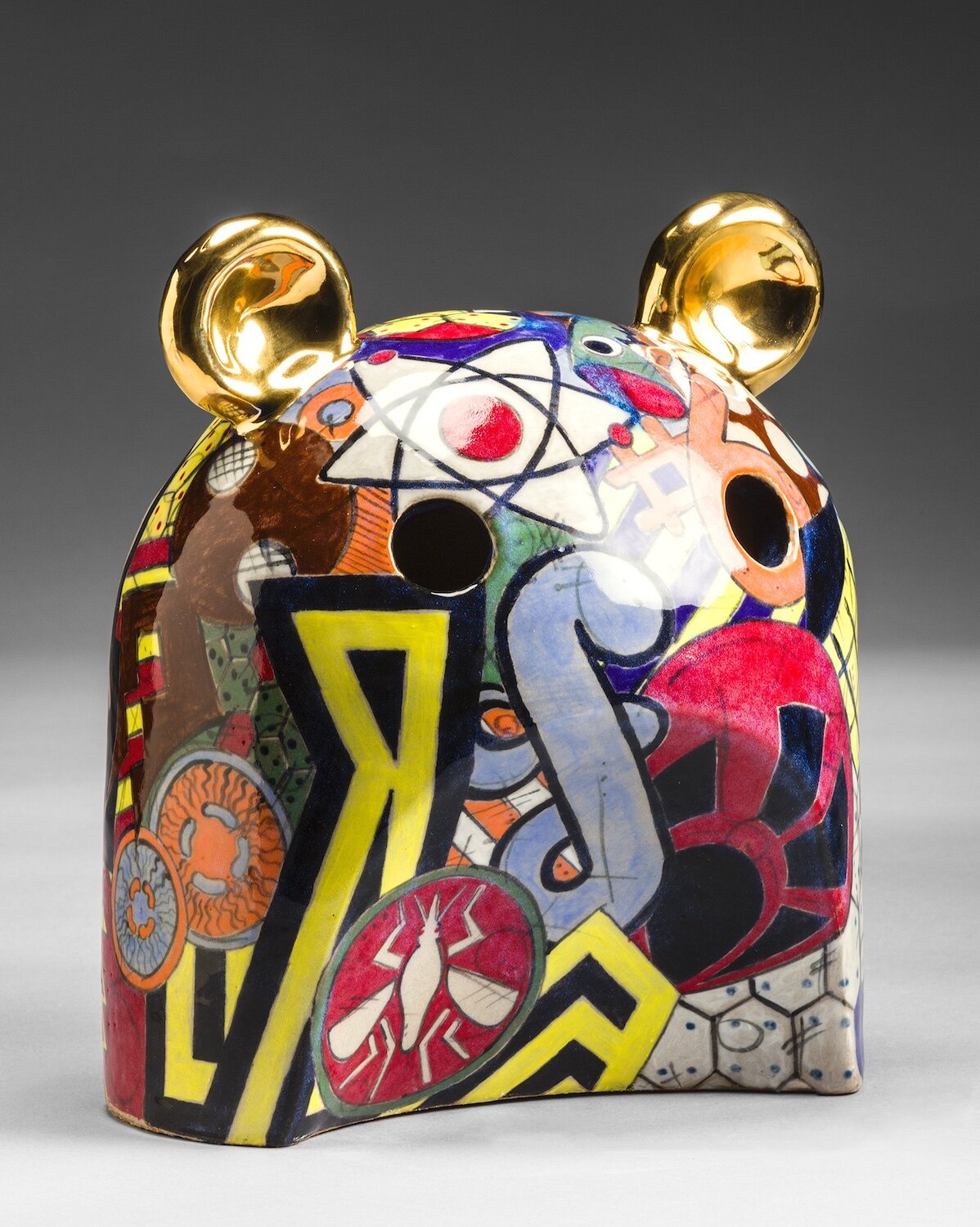
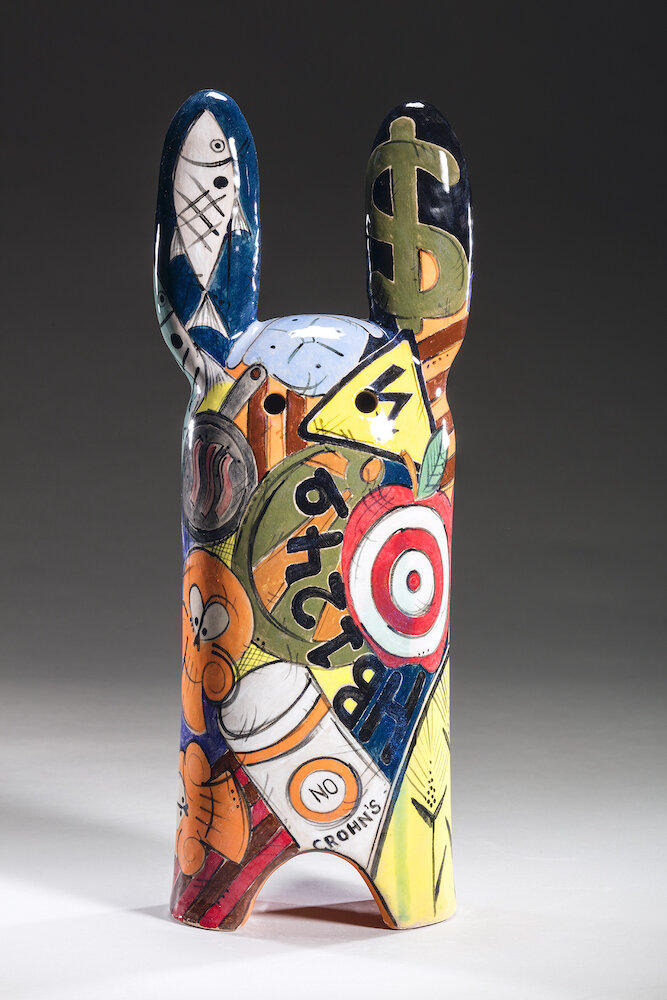
AAS: Teaching ceramics must have been, I am guessing, difficult or impossible last year if students were attending HSU virtually. Will things be back to semi-normal this fall?
AC: When the pandemic hit, we all quickly had to switch gears. My studio classes are so hands on. I knew that whatever I offered my students virtually just wouldn’t be the same as a physical class. Home life was crazy. My daughters were virtual, my wife contracted Covid, and I was trying to create content for my students. We all made the best of it. During Fall 2020 I opted to return to in person classes but had to be super flexible. On occasion students would need to quarantine for two weeks and I was concerned about bringing Covid home to my family. As of now, Henderson is open for business. It looks as though the Governor Hutchinson is looking to amend a law banning mask mandates. I hope that happens. I love teaching but the number of positive cases rising in Arkansas and the spread of the delta variant has me concerned for everyone’s safety.

